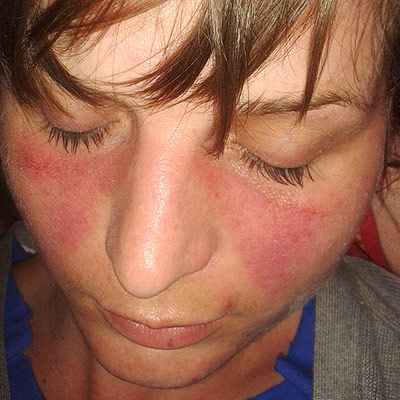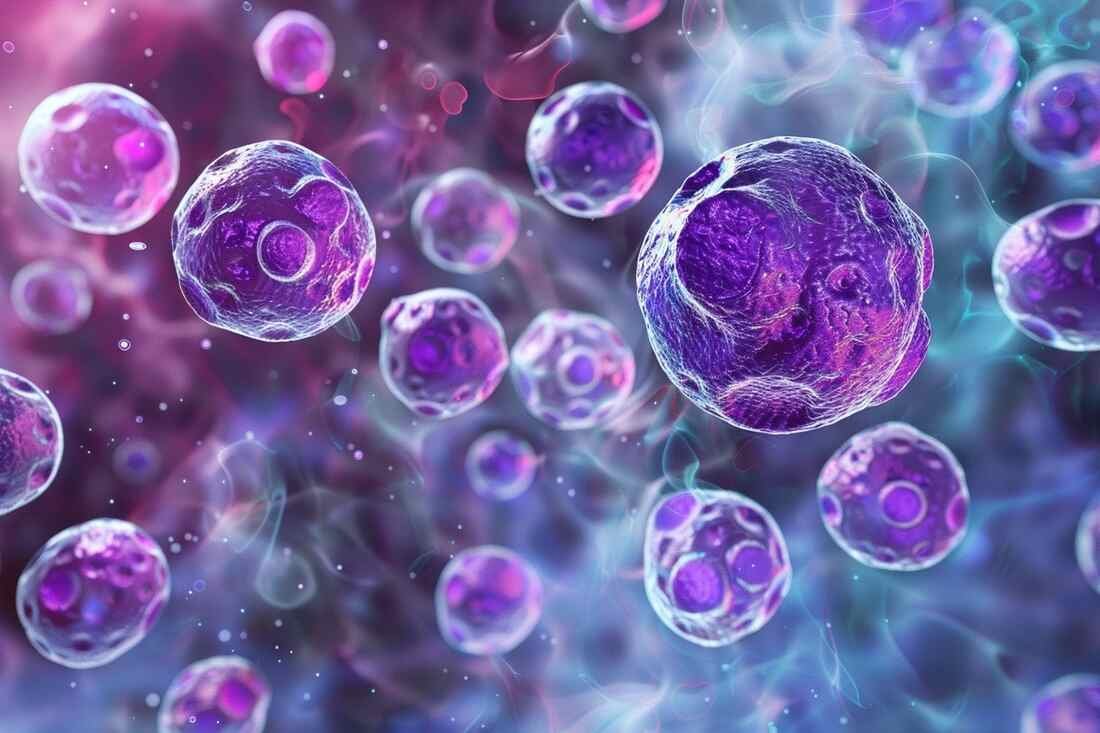Lupus Disease
Lupus disease is an autoimmune disease where the immune system attacks healthy cells, affecting various body parts like joints, skin, kidneys, and heart.
The term “lupus” will be used in this article to designate this disease more simply. There are other forms of lupus, including:
- discoid lupus erythematosus (which can progress to systemic lupus).
- lupus medicamentosa, and neonatal lupus.
Quick overview of this disease
What are the first signs of this disease?
The wolf-shaped facial rash characteristic of lupus. The most suggestive symptom of systemic lupus erythematosus is a rash on the face, appearing during a flare-up of the disease. These red plaques predominate on areas of skin exposed to the sun (photosensitivity).
What are the pains of lupus?
Joint pain and inflammation (arthritis) are very common in lupus. They mainly affect the fingers, hands, shoulders and knees. But unlike rheumatoid arthritis (RA), lupus rarely destroys the joints.
Definition and explanations
This diseases occurs when the immune system attacks cells in the body and destroys them. It can affect many parts of the body, including joints, skin, kidneys, heart, etc.
This is why it is called systemic or “systemic” lupus. Lupus can cause symptoms as different as unexplained fevers, joint pain and swelling, blurred vision and many more.
It mainly affects women of childbearing age, from 15 to 40 years old. The symptoms of the disease and their severity vary widely from person to person.
Causes of lupus
For reasons we still don’t know (perhaps a combination of environmental, hormonal and genetic factors), the body makes antibodies that attack its own healthy tissue.
The immune system is a complex network of organs, tissues, cells and factors circulating in the blood. Usually, it protects the individual against diseases.
These autoimmune reactions can be very harmful to the body and cause significant inflammatory reactions.
Evolution of lupus
Lupus is characterized by alternating periods of flare-ups (with symptoms) and periods of remission.
During attacks, the disease is exacerbated: the symptoms worsen and blood tests reveal the presence of abnormal antibodies, which attack the body. Then, the symptoms gradually diminish and totally or partially disappear.
Periods of remission can last for weeks, months, and even years. Although it is a chronic condition, most people with lupus will not be continuously ill throughout their lives.
Lupus Triggers
Stress, overwork, sun exposure, and becoming pregnant or giving birth can trigger this disease by a mechanism that is not yet known (which does not mean that these factors are the cause).
Also, certain medications used to treat another illness can trigger symptoms of this disease. This is called drug lupus. Symptoms usually go away when the person stops taking the offending drug.
Certain medications taken for long periods can trigger drug-induced lupus, and researchers believe that exposure to certain substances, such as pesticides, mercury or silica, also increases the risk of developing lupus.

Typical facial erythema, “butterfly wing” or “vespertilio” or “wolf mask”. Doktorinternet, CC BY-SA 4.0, via Wikimedia Commons
What are the types of lupus?
There are different types of lupus erythematosus, which do not cause the same symptoms.
Systemic Lupus Erythematosus (SLE)
Formerly called “systemic lupus erythematosus” or “acute systemic lupus erythematosus”, we now speak of “systemic lupus”. This type of lupus affects many parts of the body. Many lupus patients do not present with erythematous cutaneous involvement, the term systemic lupus is therefore now primarily used.
A person with SLE might experience joint pain, skin rashes, and kidney issues simultaneously.
Discoid lupus erythematosus
This form is limited to the skin and does not affect the internal organs of the body. It is manifested by well-limited, often multiple and symmetrical patches that predominate on the face, sometimes also taking on a butterfly wing arrangement or circular shapes. Involvement of the ears, eyebrows and scalp is possible.
The lesions of discoid lupus have a different evolution from those of systemic lupus, and leave very unsightly permanent scars, hence the urgency of treatment. There are forms of systemic discoid lupus with lesions that can appear on the trunk and limbs; the lesions then predominate on the elbows and extremities.
Someone with discoid lupus might have red, scaly patches on their face and scalp, but no internal organ involvement.
Isolated cutaneous
Unlike systemic lupus erythematosus, isolated cutaneous lupus exclusively affects the skin on the face. Certain treatments, such as the use of UV protection, antimalarial therapy, corticosteroids and/or calcineurin inhibitors, can improve the appearance of the skin, limit scarring and prevent new skin lesions .
Induced or drug-induced
It appears following the prolonged intake of certain medications such as doxycycline (antibiotics prescribed against acne), Bactrim® (another antibiotic), certain antituberculosis drugs, beta-blockers (antihypertensive drugs), certain antiepileptics (carbamazepine) and anti-epileptics. -TNF.
If someone develops lupus symptoms after taking a specific drug, stopping the medication often alleviates the symptoms.
Neonatal
Is linked to the presence in the mother of anti-SSA (also called anti-Ro) or SSB (or anti-La) antibodies which will affect the fetus or newborn. A baby born with neonatal lupus may have a rash or liver issues, which usually resolve over time.
Lupus symptoms
Non-specific symptoms
- Extreme tiredness;
- Unexplained and continuous weight loss or weight gain due to fluid retention;
- Unexplained bouts of fever;
- Swollen glands.
Specific symptoms
- Pain (arthralgia), stiffness and swelling in the joints. These are the most common manifestations of lupus;
- A red patch on the top of the cheeks and at the root of the nose in the shape of butterfly wings;
great sensitivity to the sun, which manifests as red rashes that occur on areas of the skin exposed to the sun, especially the hands, chest, elbows; - Raised, “crusty,” disc-shaped patches may appear on the face, scalp, and chest. They are characteristic of cutaneous or discoid lupus, which only affects the skin;
- Small, painless sores (ulcers) in the mouth or nostrils;
- Chest pain during deep breaths, and sometimes coughing and difficulty breathing due to lung damage;
- Swelling of the legs (oedema);
- If the disease affects the heart, it can cause arrhythmia and more rarely heart failure;
- Depression, difficulty thinking clearly and memory problems;
- Muscle pain.
Other symptoms
- Hair loss;
- Blurred vision and dry eyes;
- In cold or stress: fingers and toes turn blue or pale easily. We talk about Raynaud’s disease;
hives; - Headaches, seizures;
- The formation of blood clots in the blood vessels (thrombosis);
- Kidney damage, which initially shows no symptoms. It can be detected, among other things, by regular urine tests;
- Anemia, i.e. a drop in the number of red blood cells or the level of hemoglobin in the blood;
susceptibility to infections due to damage to the immune system.
Note: Some forms of lupus (discoid lupus, subacute cutaneous lupus erythematosus) are limited to skin rashes and sun sensitivity.
Read also: Tropical Diseases | Examples, Infection and Transmission
Treatments
Drug treatments
Immunoglobulin infusions
Immunoglobulin (antibody) preparations are obtained from donor blood. Administered intravenously, they have an anti-inflammatory action since they partly neutralize the auto-antibodies, that is to say the abnormal antibodies which turn against the body and are involved in this disease.
Immunoglobulin infusions are reserved for cases of lupus resistant to other treatments, such as corticosteroids.
Pain medications (nonsteroidal anti-inflammatory drugs)
Acetaminophen (Tylenol®, Atosol®) and over-the-counter anti-inflammatories25 (ibuprofen, Advil® or Motrin) can be used to ease joint pain, when lupus is not too severe or flare-ups are not are not too intense.
Doctors, however, advise people with more severe lupus not to take over-the-counter painkillers on their own. These drugs can increase the risk of complications from lupus, especially kidney damage. It may take some time to find the right anti-inflammatory and adjust the dose with the doctor.
Corticosteroids
Corticosteroids, and in particular prednisone and methylprednisone, are the most effective anti-inflammatories for treating this disease, when the disease affects several organs.
Used since the early 1960s against lupus, prednisone (Deltasone®, Orasone®) quickly became an essential drug for improving the quality of life of patients. It helps reduce inflammation and control symptoms, especially when flare-ups occur.
However, corticosteroids taken in high doses or over a long period of time can cause a range of side effects, including bruising, mood swings, diabetes25-26, vision problems (cataracts), increased blood pressure and fragile bones (osteoporosis). The dose is finely adjusted with the doctor so as to obtain the least possible adverse effects.
In the short term, the main side effects of corticosteroids are weight gain and swelling of the face and body (edema). The use of calcium and vitamin D supplements helps reduce the risk of osteoporosis.
Local creams and treatments
Skin rashes are sometimes treated with creams, most often based on corticosteroids.
Anti-malarial drugs
Hydroxychloroquine (Plaquenil®) and chloroquine (Aralen®), drugs also used to treat malaria, are effective in treating this disease when nonsteroidal anti-inflammatory drugs are not enough. They reduce joint pain and swelling and help treat skin rashes. Either of these medications can be taken from spring to fall to prevent the onset of sun damage. Hydroxychloroquine is also used as a background treatment to prevent relapses.
The main side effects of these drugs are stomach pain and nausea.
Immunosuppressants
Immunosuppressive agents reduce the activity of the immune system directed against its own organs and tissues. These powerful drugs are used in a small proportion of people when prednisone does not help symptoms or when it causes too many side effects. They are needed when lupus affects the functioning of the kidneys or nervous system.
The most frequently used are cyclophosphamide (Cytoxan®), azathioprine (Imuran®) and mycophenolate mofetil (Cellcept®). In some patients, methotrexate (Folex®, Rheumatrex®) can also be used at low doses as a background treatment.
These drugs also have their share of side effects, the most important of which are a greater susceptibility to infections and a higher risk of developing cancer. A new drug, belimumab (Benlysta) may be effective in some cases of this disease; its possible side effects are nausea, diarrhea and fever.
Other treatments
Immunoglobulin infusions (antibody) preparations are obtained from donor blood. Administered intravenously, they have an anti-inflammatory action since they partly neutralize the auto-antibodies, that is to say the abnormal antibodies which turn against the body and are involved in lupus. immunoglobulins are reserved for cases of lupus resistant to other treatments, such as corticosteroids.
The cause of lupus
The exact cause of lupus is unknown, but it likely involves a combination of genetic, environmental, and hormonal factors. Treatment typically focuses on managing symptoms and minimizing flare-ups through medications and lifestyle adjustments.
What is the life expectancy with the lupus disease?
The survival prognosis for people with this disease has improved dramatically in recent decades. Life expectancy exceeds 95% at 10 years with appropriate care.
Information: Cleverly Smart is not a substitute for a doctor. Always consult a doctor to treat your health condition.
Sources: PinterPandai, Mayo Clinic, Web MD, Health Line, National Hospital Service (NHS UK), National Center for Biotechnology Information (NCBI), Centers for Disease Control and Prevention (CDC), MedlinePlus is a service of the National Library of Medicine (NLM) – part of the National Institutes of Health (NIH)
Photo powered by Midjourney



